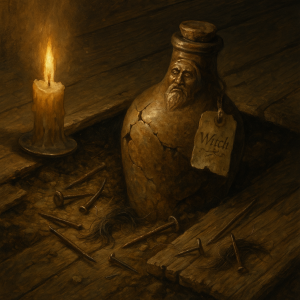Witch Bottles
21st October 2025 by | Uncategorized
The candle trembles, and the timbers above my head creak in the stillness. The night air is filled with distant sounds: an owl’s mournful cry, the sharp bark of a fox, the restless whisper of the wind. These are the sounds of old England, and they carry with them memories of how our ancestors sought protection from unseen forces.
Among the most curious of these defences were the witch bottles. From the late 16th century through the 17th, people fearful of curses and bewitchment turned to these humble vessels. Crafted most often from salt-glazed stoneware, like the German “Bellarmine” jugs with their bearded faces, they were filled with strange contents: bent nails and iron pins to pierce the witch’s spirit, strands of hair or nail clippings to link the bottle to its owner, and urine, which was thought to carry the essence of the bewitched.
These bottles were buried beneath hearthstones, thresholds, and at the corners of houses. The fire would warm them, or the earth conceal them, drawing the witch’s malice into the vessel where it could do no harm. Some were later heated in the flames until they burst, the violent crack believed to break the spell and torment the witch who had cast it.
Over 200 such bottles have been unearthed by archaeologists and builders. They lie hidden still, in walls and beneath old floors, silent guardians left by those who lived in dread of sorcery.
The witch bottle reminds us that witchcraft was not only a charge of accusation and death, but a daily fear — and that for ordinary people, a jug of pins and urine might seem the strongest shield against the Devil’s hand.
Gemma
The past is never silent.